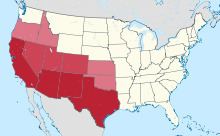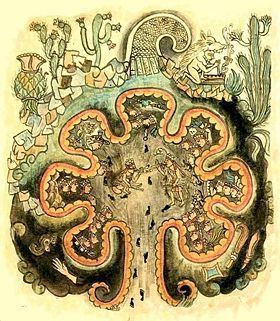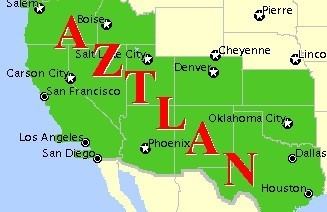 | ||
Similar Tamoanchan , Chicomoztoc, Colhuacan (altepetl) | ||
Viaje a aztl n el origen de m xico con pascal k in greub
Aztlán (from Nahuatl: Aztlān, [ˈast͡ɬaːn]) is the legendary ancestral home of the Aztec peoples. Aztecah is the Nahuatl word for "people from Aztlan". The place Aztlan is mentioned in several ethnohistorical sources dating from the colonial period, and each of them give different lists of the different tribal groups who participated in the migration from Aztlan to central Mexico, but the Mexica who went on to found Mexico-Tenochtitlan are mentioned in all of the accounts. Historians have speculated about the possible location of Aztlan and tend to place it either in northwestern Mexico or the southwest US, although there are doubts about whether the place is purely mythical or represents a historical reality.
Contents
- Viaje a aztl n el origen de m xico con pascal k in greub
- Journey to Aztlan the Mythical Land of the Aztecs Mexico Unexplained Episode 18
- Legend
- Places postulated as Aztln
- Etymology
- Use by the Chicano movement
- Movements that use or formerly used the concept of Aztln
- Charles Truxillo
- In fiction
- In music
- References

Journey to Aztlan, the Mythical Land of the Aztecs: Mexico Unexplained, Episode 18
Legend
Nahuatl legends relate that seven tribes lived in Chicomoztoc, or "the place of the seven caves". Each cave represented a different Nahua group: the Xochimilca, Tlahuica, Acolhua, Tlaxcalteca, Tepaneca, Chalca, and Mexica. Because of their common linguistic origin, those groups are called collectively "Nahuatlaca" (Nahua people). These tribes subsequently left the caves and settled "near" Aztlán.

The various descriptions of Aztlán apparently contradict each other. While some legends describe Aztlán as a paradise, the Codex Aubin says that the Aztecs were subject to a tyrannical elite called the Azteca Chicomoztoca. Guided by their priest, the Aztec fled, and, on the road, their god Huitzilopochtli forbade them to call themselves Azteca, telling them that they should be known as Mexica. Ironically, scholars of the 19th century—in particular Alexander von Humboldt and William H. Prescott—would name them Aztec. Humboldt's suggestion was widely adopted in the 19th century as a way to avoid confusion between modern Mexicans and the pre-Hispanic civilization.

Aztlán plays a slightly less important role in Aztec legendary histories than the migration to Tenochtitlán itself. Some say that the southward migration began on May 24, 1064 CE, after the Crab Nebula events from May to July 1054. Each of the seven groups is credited with founding a different major city-state in Central Mexico.

The newest translation of the "Anales de Tlatelolco" gives the only date known related to the exit from Aztlan; day-sign "4 Cuauhtli" (Four Eagle) of the year "1 Tecpatl" (Knife) or 1064-1065, and correlated to January 4, 1065.
Two city-states reputedly had an Aztec foundation:
These city-states formed during the Late Postclassic period of Mesoamerican chronology (ca. 1300–1521 CE).
Cristobal del Castillo mentions in his book "Fragmentos de la Obra General Sobre Historia de los Mexicanos", that the lake around the Aztlan island was called Metztliapan or "Lake of the moon."
According to Aztec legends, the Mexica tribe emigrated last. When they arrived at their new homeland, the present-day Valley of Mexico, all available land had been taken, and they were forced to squat on the edge of Lake Texcoco.
Places postulated as Aztlán
While Aztlán has many trappings of myth, similar to Tamoanchan, Chicomoztoc, Tollan, and Cibola, archaeologists have nonetheless attempted to identify a geographic place of origin for the Mexica.
Friar Diego Durán (c. 1537–1588), who chronicled the history of the Aztecs, wrote of Aztec emperor Moctezuma I's attempt to recover the history of the Mexica by congregating warriors and wise men on an expedition to locate Aztlán. According to Durán, the expedition was successful in finding a place that offered characteristics unique to Aztlán. However, his accounts were written shortly after the conquest of Tenochtitlan and before an accurate mapping of the American continent was made; therefore, he was unable to provide a precise location.
There is a lake around Cerro Culiacan, Lake Yuriria, that makes the mountain look very much like an island when photographed from the water, and is similar to the illustration at right.
In 1887, Mexican anthropologist Alfredo Chavero claimed that Aztlán was located on the Pacific coast in the state of Nayarit. While this was disputed by contemporary scholars, it achieved some popular acceptance.
Eduardo Matos Moctezuma presumes Aztlán to be somewhere in the modern-day states of Guanajuato, Jalisco, and Michoacán. Indeed, scholars are all consistent in naming the measures of "150 leagues" from Tenochtitlan that were documented by the Spanish scribes taking notes from conquered Mexica as the distance to the place of origin, coinciding in all ways at Chicomoztoc, "Cerro del Culiacan", which is indeed a humped mountain when seen from the south face.
Etymology
The meaning of the name Aztlan is uncertain. One suggested meaning is "place of Herons" or "place of egrets"—the explanation given in the Crónica Mexicáyotl—but this is not possible under Nahuatl morphology: "place of egrets" would be Aztatlan. Other proposed derivations include "place of whiteness" and "at the place in the vicinity of tools", sharing the āz- element of words such as teponāztli, "drum" (from tepontli, "log").
Aztlán (Spanish: [aθˈtlan]; American Spanish: [asˈtlan]) is the Spanish-language spelling and pronunciation of Nahuatl Aztlān [ˈas.tɬaːn]. The spelling Aztlán and its matching last-syllable stress cannot be Nahuatl, which always stresses words on the second-to-last syllable. The accent mark on the second a added in Spanish marks stress shift (from oxytone to paroxytone), typical of several Nahuatl words when loaned into Mexican Spanish.
Use by the Chicano movement
The concept of Aztlán as the place of origin of the pre-Columbian Mexican civilization has become a symbol for various Mexican nationalist and indigenous movements.
The name Aztlán was first taken up by a group of Chicano independence activists led by Oscar Zeta Acosta during the Chicano movement of the 1960s and 1970s. They used the name Aztlán to refer to the lands of Northern Mexico that were annexed by the United States as a result of the Mexican–American War. Aztlán became a symbol for mestizo activists who believe they have a legal and primordial right to the land. In order to exercise this right, some members of the Chicano movement propose that a new nation be created, a República del Norte.
Aztlán is also the name of the Chicano studies journal published out of the UCLA Chicano Studies Research Center.
Movements that use or formerly used the concept of Aztlán
Charles Truxillo
A prominent advocate of Aztlán was Professor Charles Truxillo formerly of the University of New Mexico (UNM), who envisioned a sovereign Hispanic nation called the República del Norte (Republic of the North) that would encompass the Northern Mexico, Baja California, California, Arizona, New Mexico, Texas and southern Colorado.
Truxillo stated that he did not like the terms 'Hispanic' or 'Latino', saying that they are racist, stating that American society is meant to conquer and divide, and preferred Norteño or Indio-Hispano (literally Indian-Hispanic, a term used by Reies Tijerina, a man whom Truxillo admired).
Truxillo, who taught at UNM's Chicano Studies Program on a yearly contract, stated in an interview that "Native-born American Hispanics feel like strangers in their own land. We remain subordinated. We have a negative image of our own culture, created by the media. Self-loathing is a terrible form of oppression. The long history of oppression and subordination has to end” and that "Along both sides of the U.S.-Mexico border “there is a growing fusion, a reviving of connections.... Southwest Chicanos and Norteño Mexicanos are becoming one people again.”" Truxillo stated that Hispanics who have achieved positions of power or otherwise are “enjoying the benefits of assimilation” are most likely to oppose a new nation, explaining that “There will be the negative reaction, the tortured response of someone who thinks, 'Give me a break. I just want to go to Wal-Mart.' But the idea will seep into their consciousness, and cause an internal crisis, a pain of conscience, an internal dialogue as they ask themselves: 'Who am I in this system?”' Truxillo believed that the República del Norte would be brought into existence by "any means necessary" but that it was unlikely to be formed by civil war but rather by the electoral pressure of the future majority Hispanic population in the region. Truxillo added that he believed it was his job to help develop a “cadre of intellectuals” to think about how this new state can become a reality.
In 2007, the UNM reportedly decided to stop renewing Truxillo's yearly contract. Truxillo claimed that his firing was due to his radical beliefs, arguing that "Few are in favor of a Chicano professor advocating a Chicano nation state."
